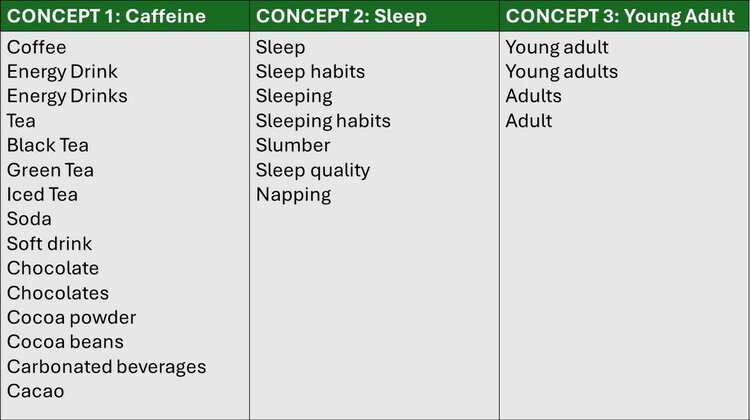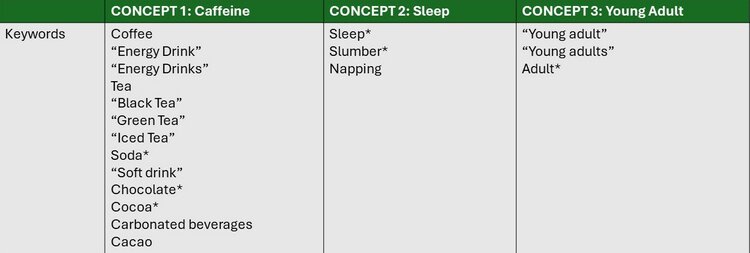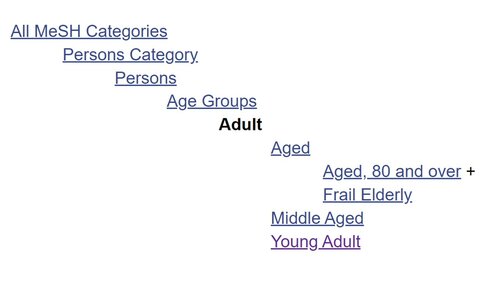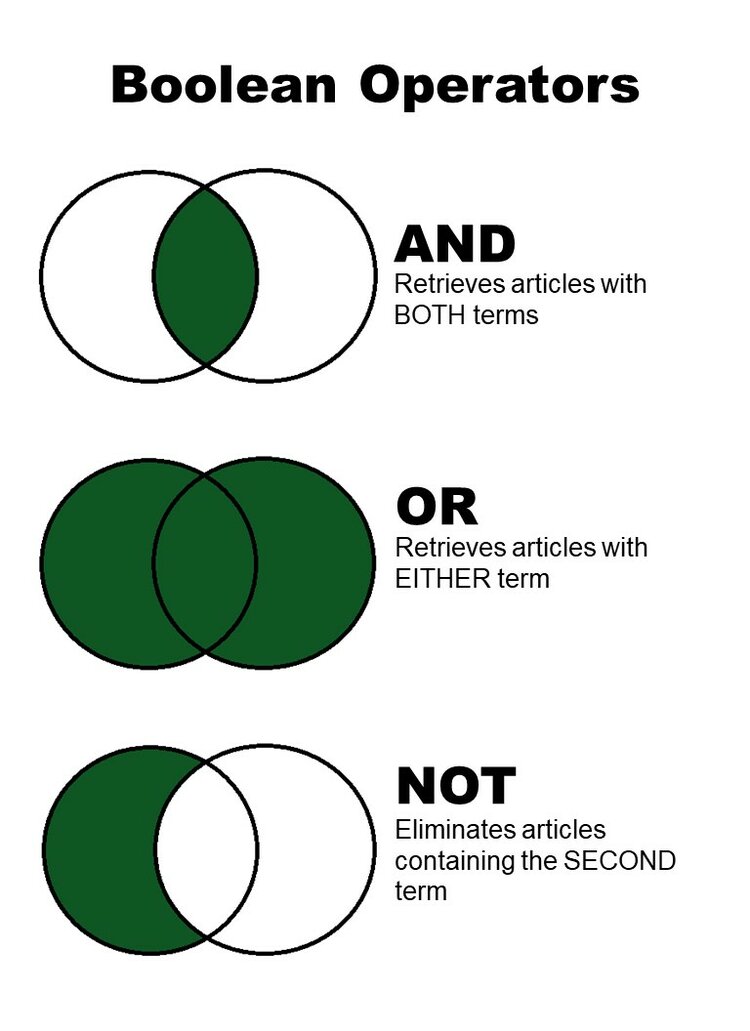Accessibility Options:
Welcome

Welcome to the Systematic Search Strategy Guide! This is a step by step guide on creating a search strategy for researchers conducting systematic reviews. However, it can be used by anyone who wants to create an effective search strategy.
Note
Parts of this research guide has been adapted from other systematic review library guides like Conduct A Systematic Review Guide originally created by Professor Barbara M. Sorondo for Florida International University and University of Tasmania's Systematic Reviews for Health Guide
Subject Specialist
-

Saily Marrero
Nursing & Health Studies, Biology, and Psychology Librarian
305-284-2040
Please provide a brief description of the topics or issues you would like to discuss during our consultation.
Relevant Guides
Develop a Research Question
Think of the research topic you are interested in and create an answerable question. Your research question should be clear, focused, but not too specific or too broad.
PICO is one of the many frameworks available you can use to create your research question. PICO stands for the following:
P - Population, Patient, or Problem: Important characteristics of a patient
I - Intervention: Main intervention or therapy
C - Comparison: This is optional depending on your research but it stands for an alternative treatment (exp. placebo, no disease, absence of risk factor, etc.).
O - Outcome: Clinical outcome you are trying to measure (exp. weight loss, reduced mortality, infection rate)
For more frameworks visit the University of Tasmania Library Guide
Identify Inclusion and Exclusion Criteria

Decide what articles, studies, or characteristics you want included in your review. This will help inform what your inclusion and exclusion criteria should be for later when you're ready to screen your results.
- Inclusion Criteria: Characteristics an article MUST have to be included in the review.
- Examples: A specific population, random assigned participants
- Exclusion Criteria: Characteristics of an article that DISQUALIFY it from being included in a review.
- Examples: Studies older than 10 years, foreign language, a certain study design
PRO TIP: If you are creating a search strategy for a Systematic Review, create a protocol using the first 23 items in the MECIR checklist. This will help you plan ahead and think about your inclusion/exclusion criteria and see if there are any gaps in your research plan.
Other Resources
University of Texas Systematic Review Guide: This is a guide on how to to formulate and use frameworks for your research question.
Systematic Reviews of Complex Interventions: Framing the Review Question: This is an article on the best practice to creating a research question for complex interventions
Methodological Expectations of Cochrane Intervention Reviews (MECIR): Items C1-C23 will help you develop a protocol for your review. Overall, MECIR is a step-by-step guide on how to conduct a systematic review.
PRISMA-P: This is a checklist used to REPORT systematic review protocols.
JBI Scoping Review Protocol: This is an article on the best practices for reporting scoping review protocols.
Identify Your Keywords
Go back to your question and identify the main points of your question.
Example Question: How does caffeine affect sleep in young adults?
From the question above, we can identify 3 key concepts:
- Caffeine
- Sleep
- Young Adults
Keyword Harvesting
Begin brainstorming for synonyms and other related terms of your established keywords. Start out by:
- Looking at words in titles, abstracts, and author keywords in articles
- Scan articles for alternative spelling variants, abbreviations, acronyms, medical terms, and brand names
- Speak to experts in the field or colleagues
- Repeat subject headings as keywords (more on this later)
- Look at other search strategies
Keep a document with a list of all your terms.
What are Keywords and How to Find Them
Translating the Research Question
Example

Other Resources
FIU Identify Keywords: This step by step guide will show you how to identify your keywords and the steps in conducting a systematic review
Hirsh Health Sciences Library: Use the Search Term Chart to organize, save, and track the terms used in your search strategy.
Listing Key Words: This website will give you a step by step guide on how find, list, and expand on your keywords.
Phrase Searching
Phrase searching allows users to search for phrases or multi word terms rather than searching each individual word on its own and resulting in random order of keywords. For most databases use quotation marks (" ") around the phrase. This is especially helpful when the individual words in a phrase are common.
Examples
- "skin cancer"
- "panic disorder"
- "heat exhaustion"
Truncation
Truncation is a searching tool that helps you finf variations of a word by including different endings. As a result it should broaden your search results. To use truncation, put an asterisk (*) at the end of a the root word.
Example
- Teen* = Teen, Teens, Teenager, Teenagers, Teenhood, Teenage
NOTE: Be careful when you use truncation because depending where you put the asterisk, you might be including other terms you don't want in your search. For example if one of your terms is training and you put train*, you will not only get training but also trains and trainwreck.
Note on Combining Truncation & Phrase Searching
Some databases like PubMed will not let you combine phrase searching and truncation for the same term. Instead, choose one or the other. If there's a multi word term, use phrase searching and if it's a single word with multiple endings, use truncation.
Example

Here's an updated table with all my terms using truncation and phrase searching.
Choose Your Databases

Choose your databases according to your research topic. For example, if your topic is about learning and memory, then databases like PsycINFO and PsycARTICLES are more appropriate because of their focus on Psychology. However, if your topic is on diabetes, biomedical databases like PubMed and Embase are more appropriate. If you are unsure of what databse to start with please contact your subject librarian to see which databases are appropriate for your review.
Below you will find a short list of databases by subject:
Biomedical
CINAHL Plus
Primary index to the international literature of nursing and health.
LILACS
LILACS database is maintained and updated by educational, research and, health institutions, from government and private sector.
Comprehensive index to the international literature of biomedicine including clinical practice, psychosocial issues, health care administration, medical research, nursing, and more.
PubMed
Provides access to citations for biomedical articles from Medline and life science journals. Citations may include links to full-text articles.
Embase
Embase is a comprehensive biomedical literature database that provides over 30 million abstracts and indices from published, peer-reviewed literature, in-press publications and conferences covering the most important international biomedical literature from 1947 to the present day.
SPORTDiscus with Full Text
Indexes international literature of sports medicine, exercise physiology, sports psychology, training, nutrition, coaching, sociology of sports, and related topics. Also covers recreation, games, play, and dance.
Psychology
PsycARTICLES
A source for full-text, peer-reviewed scholarly and scientific articles in psychology.
PsycINFO
Abstracts of scholarly journal articles, book chapters, books, and dissertations, in behavioral science and mental health. Citations and summaries date back to early 1800s; journal coverage from 1887 to present. From the American Psychological Association.
ERIC (EBSCO)
Education Resources Information Center (ERIC) is an authoritative database of indexed and full-text educational literature and resources. Essential for education researchers of all kinds, it features journals included in the Current Index of Journals in Education and Resources in Education Index.
Science
SCOPUS
Covering the life, physical, health, and social sciences, Scopus is a large abstract and citation database of research literature and web sources.
Web of Science
Web of Science, published by Thomson Reuters, is a multi-disciplinary database that provides integrated access to over 8,000 key research journals indexed in: Science Citation Index Expanded, Social Science Citation Index, and Arts and Humanities Citation Index.
ScienceDirect
Science Direct is a full text database offering journals and books from the leading scholarly publisher Elsevier. It has particular strengths in medicine and mathematics, but its nine million articles cover a wide range of scientific topics. The collection stretches back to 1823 and includes prominent publications including The Lancet, Cell and Tetrahedron.
SciELO
SciELO is a free database containing the full text of selected scientific and social sciences journal articles from Brazil, Chile, Cuba, Spain and Venezuela. Articles are available in one of three languages: English, Portuguese, or Spanish. Although it has a few journals in the social sciences, it is primarily a source for the biological, environmental, and physical sciences.
What are Subject Headings?
Subject headings are a type of controlled vocabulary formally assigned to artcicles within a database. Each database has their own, for example PubMed has MeSH while Embase has Emtree. Meanwhile databases like Web of Science and SCOPUS do not have controlled vocabulary and solely rely on keywords.
What are Subject Headings?
Subject Headings vs Keywords
Subject Headings
- They are assigned to articles
- Catch all articles on a given topic
- Do not depend on the author's coice of spelling or word
- Exp: "Neoplasms"[Mesh] = cancer, tumor, & neoplasms
- Exp: "Pediatrics"[Mesh] = pediatric & paediatric
- Does NOT pick up new Articles
Keywords
- Keywords are NOT assigned to articles
- Keywords are dependent on author's spelling and choice of word
- Exp: Cancer vs Neoplasm
- Exp. Pediatric vs Paediatric
- Pick up newer articles
PRO TIP: Use both keywords and subject headings for a comprehensive search strategy. You don't want to miss anything!
Keywords to Subject Headings
You can search for specific subject headings within a database. This will look different in the different databases. For example in PubMed you would search in their MeSH database, Embase has Emtree, while other databases have a Thesaurus, Index, or Headings.
Search your subject headings using your keyword list. You will need to do this for each of your keywords in every database.
In a separate row add your new subject headings to your list of terms.
If you want to learn more about subject headings and how to use them look at the videos on the right or contact your librarian.
MeSH Terms
Emtree Terms
Subject Headings & Explosions

Subject heading in databases like PubMed and Embase are organized in a hierarchy, with terms going from general to more specific as they go down the list. Both of these databases use a feature called explosion.
In the example below we see the term "adult" is more general than the terms below it. In PubMed when you add the "Adult"[Mesh] to your search, you are also searching everything underneath adult. In other words "Adult"[Mesh] = Adult + Aged + Aged, 80 and over + Frail Elderly + Middle Aged + Young Adult. This is explosion.

There's a couple of things to keep in mind when deciding to use the explosion:
- If you decide to use the explosion, then you will also need to add the more specific terms to your keyword list and use them in the other databases.
- If you do not want to use explosion, then you will need to turn it off on the database's subject selection screen.
- In PubMed use the button for Do not include MeSH terms found below this term in the MeSH hierarchy
- In Embase use the Index term or Major focus options
For example, if I only want to use Adults and Young Adults, but not the rest, my subject terms would be "Adult"[Mesh:NoExp] and "Young Adult"[Mesh]. This is telling the database you want the Adult and Young Adult MeSH terms, but not Aged, Middle Aged, or Frail Elderly MeSH terms.
Explosions in PubMed
Exploding Databases
Databases that explode subject headings by default:
- Embase
- PubMed
Databases that DO NOT explode subject headings by default:
- CINAHL
- MEDLINE
- PsycINFO
- ERIC
- Other EBSCOhost Platform Databases
Example

In this example we have all of the keywords with their corresponding subject heading. Notice how I also have each subject as a keyword too. You will want to add more rows to include the other databases.
Boolean Operators
Boolean Operators are words AND, OR, and NOT, and they are used to connect your search terms in a database.
AND
Using AND in your search will find articles that include BOTH terms. So if you search caffeine AND anxiety, the database will find articles that include both terms. This will narrow your results.
OR
Using OR in your search will find articles that include EITHER term. So if you search caffeine OR anxiety, the database will find every article about caffeine and every article about anxiety. As a result, your search will be broaden.
NOT
Using NOT in your search will exclude the second term in your search. For example, if you search caffeine NOT anxiety, the database will eliminate all articles with anxiety including the ones that are about caffeine too. Because a NOT search can potentially eliminate relevant articles, use with caution or avoid them altogether when conducting a systematic review.
Boolean Operators Video

Putting it All Togther
1. Start out concept by concept. For my sleep concept I have all these words:
- sleep*
- slumber*
- napping
- "Sleep"[Mesh]
To put it all together use OR in between all your terms and it will look like this
sleep* OR slumber* OR napping OR "Sleep"[Mesh]
Do this for each concept.
2. Wrap each concept with paranthesis. This is called nesting and it helps with organizing your search strategy and keeps related concepts together.
Example: (sleep* OR slumber* OR napping OR "Sleep"[Mesh])
3. Include the word AND in between each concept.
In the following example you can see I used the following framework to put it all together: (Concept 1) AND (Concept 2) AND (Concept 3). Each concept is highlighted in a different color.

Search Overview

Run Your Search
How Do You Know You Are Done?

The short answer is when you no longer find new terms to add to your search. There will come a time when all the relevant terms are already included in your search strategy and you won't need to continue adding and modifying your search. Another good indicator is when your number of results continue to stay the same number even when new terms are being added. This is how you know your search strategy is thorough and good to go.
Apply Search Limits if Applicable
Go back to your protocol and review your search criteria and apply the ones that are applicable like year and language. You can apply this criteria by using the limiters (usually) found on the right hand side of a database. Anything else should be excluded using a screening software like Covidence.
NOTE: In many databases limiters are applied manually, meaning that newer articles might not have filters and limits assigned yet. As a result you might be unknowingly eliminating relevant articles. Usually, year and language filters are assigned automatically, and therefore safe to use.
Resources to Track Your Search Terms & Results
Overview of PRIMARY Excel Workbook for SR: Created by the University of Texas, this is a PDF guide on how to track your search data using Excel.
Saving Search Strategies with PRIMARY Excel Workbook for SR: Created by the University of Texas, this is PDF guide will help you keep track of your search strategy using Excel.
Hirsh Health Sciences Library: Use the Search Term Chart to organize, save, and track the terms used in your search strategy.
Equator Network: Provides reporting guidelines for different types of reviews according to study type
Resources on Applying Database Limits
University of Tasmania - Systematic Review Guide: This is a step by step guide on creating a search strategy for Systematic Reviews. Step 8 talks about limits and criteria in databases.
Cochrane Manual - Section 4.4.5: This section of the Cochrane Manual has information about using database limits to restrict your search results by language, date, and format.
Manage Citations

Once you have perfected your search strategy and begin conducting searches, start adding them to your preferred Citation Manager. There you can organize your citations by database and deduplicate them before continuing on to Covidence. Make sure to keep a record of the terms used, limits used, the number of results retrieved in each database, and anything else you deem relevant.
If you're not using a Citation Manager and want to get started look at our Citation Guide!
Resources for Citation Managers
The following links are designed to help you get started with the citation managers available through the UM Libraries, if you run into any problems please contact the corresponding librarian.
Next Steps
1. Find other types of documents you are interested in for your review like dissertations, books, conference proceedings, government documents, etc. These types of documents are also called grey literature. For more information on grey literature make sure to check out the Grey Literature Tab under the main Systematic Review Guide.
2. Remember to document EVERYTHING! Make sure you keep detailed notes on every part of the search process like which databases you searched, when they were searched, your search strategy, terms you used, and the number of results you retrieved.
3. Read and review your results to see which articles you want to keep as part of your review. You can use Covidence to help with the screening process.
Appraisal Tools

Critical Appraisal Worksheets: These worksheets from the Duke University Medical Center Library will help you determine which articles are good to include in your review.
JBI Critical Appraisal Tools: JBI’s critical appraisal tools assist in assessing the trustworthiness, relevance and results of published papers.
Cochrane Risk of Bias Tool (RoB 2): This tool is used to assess the risk of bias in randomized trials.
Newcastle-Ottawa Scale (NOS): This tool is used to assess the risk of bias in non-randomized studies. On the website they have a manual and a scale to follow.
QUADAS-2: This is a quality assessment tool for diagnostic accuracy studies and recommended for Systematic Reviews.
AMSTAR-2: Standing for A MeaSurement Tool to Assess systematic Reviews, AMSTAR aims to help create high-quality reviews by focusing on their methodological quality.